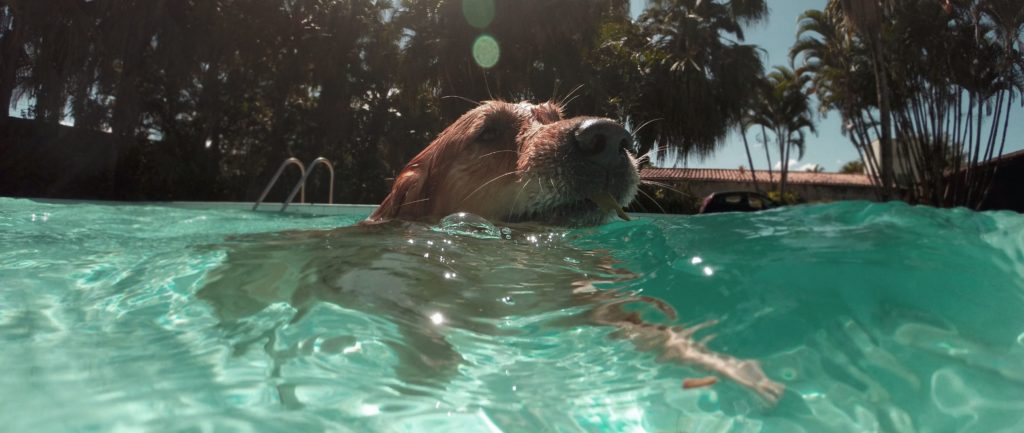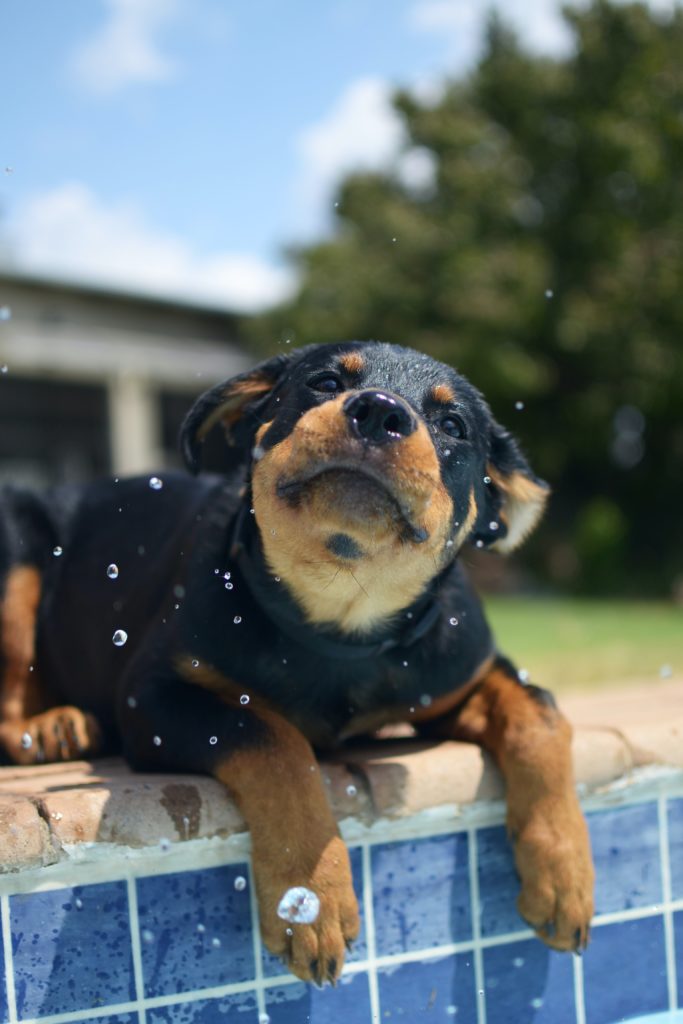Dogs and Swimming Pools

While it’s true that most dogs can swim, not all of them actually enjoy it. Some dogs’ idea of swimming involves paddling for dry land as quickly as possible, while some take to the water as if they were otters in a previous life.
With some breeds, the clue is in the name. The Irish Water Spaniel and the Portuguese Water Dog, for example, love taking the plunge, as do Poodles, Newfoundlands, Setters, Retrievers and many more. Some dogs, however, are simply not built for swimming. Dachshunds, with their short legs, and Pugs and English Bulldogs, with their short necks and poor breathing, struggle in water.
When confronted with lakes and rivers on a walk, the dog will decide for itself whether or not it wants to take a quick dip. In a garden pool, however, you need to be aware of the various safety and hygiene issues, because at some point your pet is bound to take to the water.
Mastering the Doggy Paddle
If the pool is a public one, dogs will simply not be allowed, so safety issues don’t arise. Pools in people’s backyards, however, become just as much a part of the dog’s playground as the humans’. Rule number one for pool owners – or for owners who visit friends with dog-friendly pools – is to make sure your dog is safe in the water.
A weak swimmer will tire very quickly and can soon get into trouble if unsupervised. Training your dog to swim to safety is therefore very important. Using your usual “Come!” command will usually work well. For smaller dogs, or if the pool is high-sided, a ramp should be attached to the side to allow the dog to clamber out. If the pool has steps, make sure the dog knows where they are. If the pool is large, make your dog jump in from different points, and guide them to the exit each time, to make sure they have a clear mental map of how to get out.
Another popular option is a dog life-jacket, which will allow your pet to swim while preventing it from sinking fast if things go wrong. If you never leave the dog unsupervised, these shouldn’t really be necessary; but if you are having a busy afternoon, your eye might not always be on your pet, so a dog flotation vest is great for ensuring peace of mind.
Some dogs really take to floats and inflatables (claw-proof ones made specifically for dogs, ideally). They can use them to take a break from paddling, or can simply lie on them like a human on a sun lounger.
If a dog gets itself into serious difficulties and needs rescuing, knowing how to administer CPR (Cardiopulmonary resuscitation) can save the pet’s life. There are tutorials available for this online, or you could ask your vet for advice.
 Don’t Drink the Water
Don’t Drink the Water
Dogs can quickly overheat if the sun is beating down, and they may naturally take to water to cool down. Swimming is hot business, though, and it’s far better for your pet to cool down in the shade with some fresh water to drink.
And that’s another hazard – a hot, thirsty dog in a pool will do what come naturally and drink some of the pool water. If they lap up too much of the chlorinated water, they may become sick. Again, providing some fresh water somewhere cool and shaded will prevent them drinking from the pool.
Just like a human, a dog who has spent time in the pool will need rinsing off, to remove the potentially irritating chlorine and other chemicals from its fur, eyes and skin.
Your Dog Loves the Pool, But Does the Pool Love Your Dog?
There are three major issues for a swimming pool used by dogs: bacteria, hair, and wear & tear.
The bacteria is associated with poop and pee. The dog doesn’t need to actually relieve itself in the pool for these contaminants to be released into the water. However, as long as your pool is properly maintained and chemically treated, the bacteria will be killed, so this should not be an issue.
The hair factor is more of a problem. Dog hair will accumulate in the pool filter surprisingly quickly if your pet sheds a lot. A good brushing before swimming will help, but you will still need to clean the filter and other pool machinery more often than you would with human-only swimmers.
Wear and tear is an issue with doggy paddlers because of their claws. They will scrabble at the sides of a pool, and at the bottom of a shallow area. A pool lined with plaster, pebbles or tile will withstand the clawing, while plastic or vinyl-lined pool may spring a leak. You should also bear in mind that dog claws and children swimming in the same pool may be asking for trouble, too.
Follow these simple guidelines and precautions, and pools can be enjoyed by dogs and owners alike. But don’t force the issue – some dogs love the wet stuff, while others prefer to keep their feet on dry land.
This entry was posted in Dogs
One reply on “Dogs and Swimming Pools”
Hello there, I agree that dog life jackets should be worn when allowing them to swim in pools. Prevention is always preferable to cure. You’ll also need to keep first-aid supplies for dogs on hand at all times.